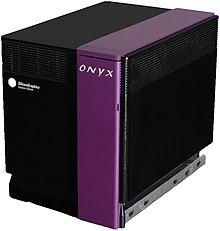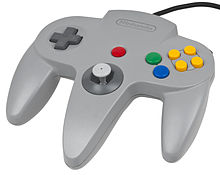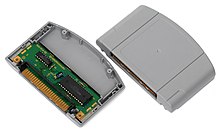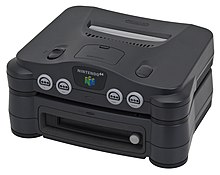Nintendo 64
The 64DD peripheral drive hosts both exclusive games and expansion content for cartridges, with many further accessories plus the defunct Internet service Randnet, but it was a commercial failure and was released only in Japan.
Philips used the software portion of its license by releasing original Mario and Zelda games on its competing CD-i console, and Sony salvaged its internal progress to develop the PlayStation.
[16] Michael Slater, publisher of Microprocessor Report said, "The mere fact of a business relationship there is significant because of Nintendo's phenomenal ability to drive volume.
The first group of elite developers selected by Nintendo was nicknamed the "Dream Team": Silicon Graphics, Inc.; Alias Research, Inc.; Software Creations; Rambus, Inc.; MultiGen, Inc.; Rare, Ltd. and Rare Coin-It Toys & Games, Inc.; WMS Industries, Inc.; Acclaim Entertainment, Inc.; Williams Entertainment, Inc.; Paradigm Simulation, Inc.; Spectrum Holobyte; DMA Design Ltd.; Angel Studios;[30][31]: 20 Ocean; Time Warner Interactive;[32] and Mindscape.
When the Ultra 64 hardware was finalized, that supercomputer-based prototyping platform was later supplanted by a much cheaper and fully accurate console simulation board to be hosted within a low-end SGI Indy workstation in July 1995.
[15] SGI's early performance estimates based upon its supercomputing platform were ultimately reported to have been fairly accurate to the final Ultra 64 product,[31]: 26 allowing LucasArts developers to port their Star Wars game prototype to console reference hardware in only three days.
Having initially indicated the possibility of utilising the increasingly popular CD-ROM if the medium's endemic performance problems were solved,[34][35]: 77 the company now announced a much faster but space-limited cartridge-based system, which prompted open analysis by the gaming press.
[11][29][49] Consumers anticipating a Nintendo release the following year at a lower price than the competition reportedly reduced the sales of competing Sega and Sony consoles during the important Christmas shopping season.
[50] Several months before the launch, GamePro reported that many gamers, including a large percentage of their own editorial staff, were already saying they favored the Nintendo 64 over the Saturn and PlayStation.
[66] Originally intended to be priced at US$250,[11] the console was ultimately launched at US$199.99 to make it competitive with Sony and Sega offerings, as both the Saturn and PlayStation had been lowered to $199.99 earlier that summer.
[50] Except for its narrower 32-bit system bus, the VR4300 retained the computational abilities of the more powerful 64-bit MIPS R4300i,[75] though software rarely took advantage of 64-bit data precision operations.
Nintendo 64 games generally used faster and more compact 32-bit data-operations,[76] as these were sufficient to generate 3D-scene data for the console's RSP (Reality Signal Processor) unit.
[96] The higher cost also created the potential for much greater losses to the game's publisher in the case of a flop, making the less risky CD medium tempting for third-party companies.
[83] Perhaps the most important reason for cartridge, observers thought, was what a later writer described as "Nintendo’s congenital need to be different, and to assert its idiosyncratic hegemony by making everyone else dance to its tune while it was at it".
[100] For instance this meant fewer textures, and/or shorter music tracks, while full motion video was not usually feasible for use in cutscenes unless heavily compressed and of very brief length.
[108] As with many other game consoles and other types of embedded systems, the Nintendo 64's architectural optimizations are uniquely acute, due to a combination of oversight on the part of the hardware designers, limitations on 3D technology of the time, and manufacturing capabilities.
As the Nintendo 64 reached the end of its lifecycle, hardware development chief Genyo Takeda repeatedly referred to the programming challenges using the word hansei (反省, 'reflective regret').
Nintendo 64 games running on custom microcode benefit from much higher polygon counts and more advanced lighting, animation, physics, and AI routines than its competition.
Many games with larger 32 or 64 MB cartridges avoid this issue entirely, including Resident Evil 2, Sin and Punishment: Successor of the Earth, and Conker's Bad Fur Day,[84] allowing for more detailed graphics with multiple, multi-layered textures across all surfaces.
For example, the VC version of Pokémon Snap allows players to send photos through the Wii's message service, and Wave Race 64's in-game content was altered due to the expiration of the Kawasaki license.
Connecting to the expansion slot at the bottom of the system, the 64DD turns the Nintendo 64 console into an Internet appliance, a multimedia workstation, and an expanded gaming platform.
[126] Previewing the Nintendo 64 shortly prior to its launch, Time magazine praised the realistic movement and gameplay provided by the combination of fast graphics processing, pressure-sensitive controller, and the Super Mario 64 game.
The review praised the "fastest, smoothest game action yet attainable via joystick at the service of equally virtuoso motion", where "[f]or once, the movement on the screen feels real".
Praising Nintendo's controversial choice of the cartridge medium with its "nonexistent" load times and "continuous, fast-paced action CD-ROMs simply cannot deliver", the review concluded that "the cartridge-based Nintendo 64 delivers blistering speed and tack-sharp graphics that are unheard of on personal computers and make competing 32-bit, disc-based consoles from Sega and Sony seem downright sluggish".
The magazine said celebrities Matthew Perry, Steven Spielberg, and Chicago Bulls players called Nintendo to ask for special treatment to get their hands on the console.
[138] After a strong launch year, the decision to use the cartridge format is said to have contributed to the diminished release pace and higher price of games compared to the competition, and thus Nintendo was unable to maintain its lead in the United States.
Five high-profile Nintendo games slated for release by Christmas 1997 (The Legend of Zelda: Ocarina of Time, Banjo-Kazooie, Conker's Quest, Yoshi's Story, and Major League Baseball Featuring Ken Griffey Jr.) were delayed until 1998, and Diddy Kong Racing was announced at the last minute in an effort to somewhat fill the gaps.
Benimaru Itō, a developer for Mother 3 and friend of Shigeru Miyamoto, speculated in 1997 that the Nintendo 64's lower popularity in Japan was due to the lack of role-playing video games.
[144] The higher price of cartidges as opposed to CD-ROM has also been cited as a reason for the system's lackluster third-party support, which led to domestically big titles, such as Dragon Quest VII, moving away from Nintendo's platforms to its rivals.
[146] Shigeru Miyamoto commented at the time that the Nintendo 64's situation in Japan was grim and that it was also tough in Europe, but that these were overcome by its success in America and therefore "the business has become completely viable".










